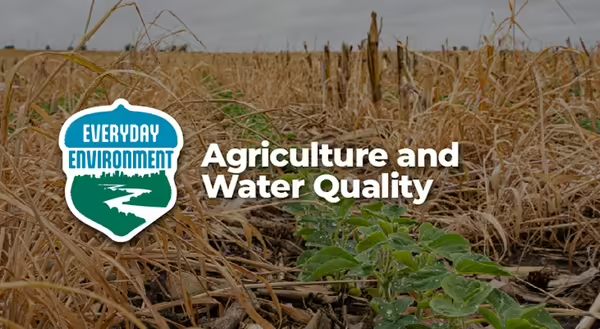
It’s a crisp spring morning, and I’m driving by the Rock River, watching as the water reflects the newly emerging leaves. Like most others across Illinois, this river is part of a complex system that connects to the Mississippi River and ultimately flows to the ocean. Hidden beneath the river surface lies a pressing challenge: nutrient pollution. This challenge is at the heart of the Illinois Nutrient Loss Reduction Strategy, a state-led initiative developed to protect these waterways for people and ecosystems.
What is the Illinois Nutrient Loss Reduction Strategy?
The Illinois Nutrient Loss Reduction Strategy, NLRS, is an initiative that was established in 2015 as part of the efforts under the Mississippi River/Gulf Watershed Nutrient Task Force. This strategy aims to address nutrient pollution by reducing the levels of nitrogen and phosphorus nutrients that flow into the Mississippi River and contribute to the Gulf's hypoxic "dead zone." Other Midwestern states also have strategies. The NLRS partners with science, technology, and industry experts to assess and reduce statewide nutrient loss.
Where do excess nutrients come from?
Currently in Illinois, excess nutrients are primarily attributed to three sectors: agriculture, point sources, and urban stormwater. These nutrients, particularly nitrogen and phosphorus, enter water bodies from varied and widespread origins, complicating their management. Nutrient loss from Illinois' 23 million acres of row crops accounts for about 80% of the state's nitrogen loss and nearly half of its phosphorus losses, impacting water quality. Point sources are identifiable locations like wastewater treatment facilities, while urban stormwater sources are point and non-point sources from urban landscapes.
Why are excess nutrients an issue?
Nutrient pollution becomes problematic when it leads to eutrophication, a process where excess nutrients in water bodies promote algal blooms. Algal blooms deplete the oxygen in the water, creating hypoxic zones, or "dead zones," devoid of sufficient oxygen to support most aquatic life. This phenomenon disrupts aquatic ecosystems and impacts the economic viability of seafood and tourism industries, costing millions annually. Moreover, it affects local water quality, posing risks to drinking water and recreational water bodies.
What agricultural strategies does the NLRS recommend to reduce nutrient loss?
The NLRS encourages the adoption of agricultural conservation best management practices to protect soil from erosion and minimize nutrients leaving a field. The NLRS has a list of approved practices that include in-field, edge-of-field, and land use change practices. There are other conservation practices that protect water quality, but the NLRS list is of practices that have been submitted by partner organizations and reviewed by the Ag Water Quality Science Team.
In-field practices such as cover crops, no-till, the Maximum Return to Nitrogen calculator, and using soil tests for phosphorus fertilizer applications help maintain agricultural productivity while protecting water quality.
Edge-of-field practices such as woodchip bioreactors and buffers are used to capture nutrients that have left a field before they enter local waterbodies.
Explore this list of all approved Illinois Nutrient Loss Reduction Strategy & Agricultural Conservation Practices.
What challenges do farmers face in implementing strategies?
Agricultural conservation isn’t a black-and-white issue. Economic realities of agriculture, such as thin profit margins and the fact that approximately 75% of Illinois land is farmed by individuals who do not own it, can complicate decision-making in agricultural conservation practices and management systems. These factors often create conflicts between maximizing economic returns and adopting environmentally beneficial practices.
What can you do to support farmers?
Supporting farmers in nutrient loss reduction is essential for broader environmental health. You can help by purchasing products from farms that employ sustainable practices. Advocating for policies that provide farmers with financial and technical support for implementing conservation practices is another powerful way to contribute. Engaging with and supporting local watershed initiatives also helps promote sustainable agricultural practices in your community, enhancing comprehensive efforts to reduce nutrient loss.
Resources to learn more
- Illinois Extension’s nutrient loss reduction website
- Nutrient Loss Reduction podcast
- Nutrient Loss Reduction blog
Thank you for reading!
Everyday Environment is a series of blogs, podcasts, webinars and videos on exploring the intricate web of connections that tie us to the natural world. Want to listen to us chat about this topic? Check out the podcast episode on this topic to hear more from the Everyday Environment team about protecting our waterways from excess nutrients.
Listen to the Podcast Sign Up for Everyday Environment Newsletter